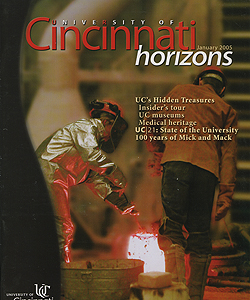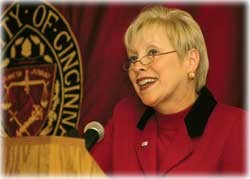UC President Nancy Zimpher's address at the All-University Faculty meeting on Oct. 20, 2004
The Year In Review
Last October, I gave a plenary address in my second week on the job. One year later, I can truly say, it has been a very productive first year!
Already this year, I have survived my first freshman convocation. Where else can you face 3,500 discerning 18-year-olds, dragged inside on a beautiful fall afternoon, and still receive what I consider to be a compliment of the highest order, opined by one freshman at the picnic afterwards: "Well it wasn't nearly as bad as I thought it would be."
Today's State of the University Address provides an opportunity for us to look back on the year's accomplishments and set a direction for the year which we have begun.
Looking first at UC's many successes, it seems like almost every day this past year we celebrated another one:
- We welcomed the largest freshman class in a decade, with this year's class almost as big.
- We announced major funding for several new research projects, with total research funding setting another record at $320 million.
- We dedicated our fabulous new Genome Research Institute.
- We opened key MainStreet facilities, including the Tangeman University Center and the Joseph Steger Student Life Center.
- We accepted an invitation to join the Big East Athletics Conference and hosted the commissioner of the Big East just this week.
- We celebrated the announcement of an American Nobel -- the Lasker Award -- to our distinguished faculty member, Elwood Jensen -- the second UC faculty member in history to win this award, the first being Albert Sabin. We can also be proud of the fact that Ohio's only two Laskers have been awarded to scholars right here at the University of Cincinnati.
- We announced the results of our annual economic impact study showing more than $3.5 billion dollars spent and 51,000 jobs provided in the Uptown Campus area alone.
- We formed a new Uptown Consortium with four other nearby employers (including Children's Hospital Medical Center, the Cincinnati Zoo, the Health Alliance and TriHealth) to improve the quality of life in our surrounding neighborhoods. Toward this end, we hired Uptown Consortium CEO Tony Brown to initiate activities, partnerships and investments that will increase safety and provide better transportation, more parking and exciting retail opportunities and housing options.
- We have begun discussions with OSU and CASE about a 3-C Collaboration, a cooperative effort across the academic interests of biomedical research, advanced manufacturing and neighborhood renewal, wherein we can help power economic development across Ohio.

 Past Issues
Past Issues



